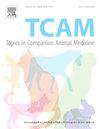Metagenomic and 16S rRNA analysis of culture-negative uterine samples identifies Brucella spp. in a female dog with pyometra
IF 1.3
3区 农林科学
Q2 VETERINARY SCIENCES
引用次数: 0
Abstract
Canine pyometra is the most prevalent reproductive disease in female dogs and involves a complex interplay of hormonal and microbial factors. Although Enterobacteriaceae are known to be the main cause of pyometra, up to 25 % of samples remain negative when classic culture methods are used. The lack of growth in conventional media raises the intriguing possibility that non-cultivable microorganisms participate in the disease. Our study aimed to address this knowledge gap by investigating the microbiota in culture-negative uterine samples from dogs with pyometra. The purulent uterine contents of dogs with pyometra (n = 79) were subjected to bacterial culture. Most of the samples showed bacterial growth of Escherichia coli (48/79, 60.7 %) or other bacterial species (25/79, 31.8 %). Samples that tested negative using the classic culture method (6/79=7.5 %) were further analyzed using 16S rRNA gene sequencing, high-throughput 16S rRNA sequencing, and shotgun metagenomics. Only three of these provided DNA of sufficient quality for further analysis, which revealed a mixture of Haemophilus/Aggregatibacter and Fusobacterium/Porphyromonas in two uterine content. In the third sample, Brucella spp. was identified as the main genus. This study suggests that pathogens that are not easily isolated by classical culture methods, including zoonotic species, may be present in the uterus of dogs with pyometra.
子宫培养阴性样本的元基因组和16S rRNA分析鉴定了勃氏菌属犬脓脓症
犬脓脓症是雌性犬中最常见的生殖疾病,涉及激素和微生物因素的复杂相互作用。虽然已知肠杆菌科是脓脓的主要原因,但当使用经典培养方法时,高达25%的样品仍然呈阴性。在传统培养基中缺乏生长提出了不可培养微生物参与疾病的有趣可能性。我们的研究旨在通过调查脓脓狗培养阴性子宫样本中的微生物群来解决这一知识差距。对脓脓犬79例化脓性子宫内容物进行细菌培养。大部分样品中检出大肠杆菌(48/79,60.7%)或其他细菌(25/79,31.8%)。经典培养法阴性(6/79= 7.5%)的样品进一步采用16S rRNA基因测序、高通量16S rRNA测序和霰弹枪宏基因组学进行分析。其中只有三个提供了足够质量的DNA进行进一步分析,结果显示两个子宫内容物中有嗜血杆菌/聚集杆菌和梭杆菌/卟啉单胞菌的混合物。在第三份样本中,布鲁氏菌属被鉴定为主要属。这项研究表明,不容易通过传统的培养方法分离的病原体,包括人畜共患病的物种,可能存在于脓脓病犬的子宫中。
本文章由计算机程序翻译,如有差异,请以英文原文为准。
求助全文
约1分钟内获得全文
求助全文
来源期刊

Topics in companion animal medicine
农林科学-兽医学
CiteScore
2.30
自引率
0.00%
发文量
60
审稿时长
88 days
期刊介绍:
Published quarterly, Topics in Companion Animal Medicine is a peer-reviewed veterinary scientific journal dedicated to providing practitioners with the most recent advances in companion animal medicine. The journal publishes high quality original clinical research focusing on important topics in companion animal medicine.
 求助内容:
求助内容: 应助结果提醒方式:
应助结果提醒方式:


